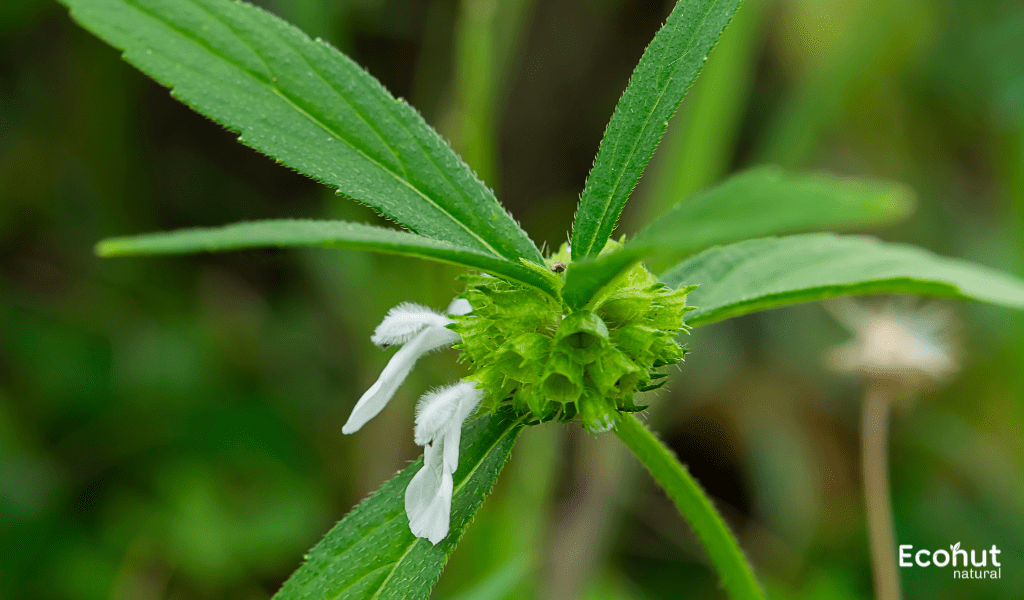Dronapushpi (Leucas cephalotes) is an herb that grows wild in various parts of Southeast Asia and India. Leucas cephalotes, the scientific name for Dronapushpi, belongs to the Lamiaceae family. The flower’s resemblance to the shape of a Droni (ship) is why it is called Dronapushpi. The plant has white sessile flowers and a yellowish-green color. It is used as a traditional Ayurvedic medicine to treat liver diseases, jaundice, snake and scorpion stings, cough, fever, colds, and respiratory disorders.
This herb has been used traditionally to cure fever, scorpion stings, cough, and snake bites. In addition, it is used to treat liver conditions, jaundice, colds, and asthma. It is an antibacterial, insecticidal, fever-reducing, larvicidal, and inflammation-reducing plant when used therapeutically.
Description
Leucas cephalotes, upright, robust plant with branches that reaches a height of 15 to 60 cm. the leaves have an intense flavor and are slender, oval, yellowish-green in color, and are 3–9 cm long by 1–2.5 cm wide. Smooth, cylindrical, zigzag roots are present, coupled with a variety of wiry, fine rootlets that vary in size, fracture, fibrousness, and flavor.
Botanical Name:
Leucas cephalotes
Family:
Lamiaceae
Leaves:
A little stalk that joins the leaf to the stem is present in Dronapushpi leaves, which are positioned in opposition to one another on the stem. The leaves have serrated borders and pointy points, oblong or elliptic in form. They smell strongly like mint and have hairs on both surfaces.
Stems:
Dronapushpi’s stems are square in shape, which is a trait shared by the Lamiaceae family. Typically, they are verdant and hairy, and as the plant grows, it will branch.
Flowers:
At the axils of the leaves—the higher angle formed by the leaf and stem—Dronapushpi bears clusters of tiny white flowers. The corolla of the flowers is bilabiate, with two lobes on the upper lip and three lobes on the lower lip.
Roots:
The fibrous root system of the Dronapushpi consists of a major taproot and several smaller lateral roots that branch out.
Habitat:
This plant is found in large parts of India and China. It is particularly prevalent as a weed in India’s cultivated areas, by the sides of roads, and on waste areas at elevations between 30 and 100 meters, with peaks as high as 1,800 meters in the Himalayas. Leucas cephalotes can also be found in the plains of Bangladesh, China, Malaysia, Mauritius, Java, and South-East Asian nations. It is also frequently found in Nepal, Pakistan, and East Asia, where it can be found from Western China to Afghanistan at a height of 1,700 meters.
Parts Used:
- Leaves
- Whole Plant
- Flowers
Dosage:
- Juice: 5 -10 ml
- Powder for decoction: 1-3g
Chemical Constituents
A wide range of chemically bioactive substances are present in Dronapushpi, such as luteolin, anisofolin A, pillion, gonzalitosin I, tricin, cosmosin, 7-oxostigmasterol, 7-oxositosterol, oleanolic acid, and 7-oxostigmasterol.
Sanskrit Synonyms
Dronachatra, Drona, Kshavapatra,Chatrini, Chitrakshupa,Phalepuspa, Drona Kurambaka, Dronapushpa – boat shaped flowers Kutumbaka, Kaundinya, Guma, Nahula,Kumbhayoni,
Other Language Names of Dronapushpi (Leucas cephalotes)
Tamil name – Tumbari
Kannada name – Tumbe, Tumbe hoovu, Tumbe gida
Telugu name – Tummi, Peddatumani
English name – Spider wort
Hindi name – Guma
Punjabi name – Gomobati, Gumma
Bengali name – Dandakalas, Halaksa, Ghalghase
Marathi name – Tubari, Tumba
Gujarati name – Kubo
Malayalam name – Tumba, Tumba Poovu
Sanskrit name – Katumba
Oriya name – Gaisha
Assamese name – Dronaphool
Scientific Classification
| Kingdom | Plantae, Plant |
| Subkingdom | Tracheobionta, Vascular plant |
| Super division | Spermatophyta, Seed plant |
| Division | Angiosperma |
| Class | Dicotyledonae |
| Sub-class | Gamopetalae |
| Family | Labiatae |
| Order | Tubiflorae |
Ayurvedic Properties
Hindi/Sanskrit
- Rasa -Katu
- Guna -Guru,Rooksha
- Virya -Ushna
- Vipaka -Madhura, Katu
English
- Taste -Pungent
- Physical Property-Heavy, Dry
- Potency- Hot
- Metabolic Property (After Digestion)-Sweet, Pungent
Dronapushpi (Leucas cephalotes) Uses
- It might aid in constipation management.
- Dronapushpi is a useful nutraceutical that enhances overall health and is an excellent source of beneficial fats.
- To relieve ear pain, the leaves’ juice is applied topically to the ears.
- Dronapushpi could facilitate better menstrual flow.
- Dronapushpi was traditionally used to treat snake bites.
- Crushed dronapushpi flowers can be inhaled to relieve migraines.
Dronapushpi (Leucas cephalotes) Benefits
Prevents Anorexia Nervosa:
Anorexia nervosa is an eating disorder characterized by self-starvation in the sufferer. Due to the person’s low self-esteem, fear of gaining weight, low self-esteem, and strong desire to lose weight, it is also linked to mental health. The person also no longer feels hungry or has the need to consume anything. A natural appetiser, doonapushpi increases hunger, facilitates better digestion, and eases eating.
Useful for Snakebites, Scorpion sting:
This herb’s anti-inflammatory qualities aid in the effective healing of wounds caused by snake and scorpion stings by lowering swelling. The body can expel toxins with the help of this herb. To relieve pain and inflammation from bug bites or other skin ailment, apply a paste made from the leaves.
Treats Fever:
Dronapushpi (Leucas cephalotes) leaves are helpful in treating a variety of fevers due to their potent anti-parasitic and temperature-lowering qualities. The leaf oil and paste have historically been used to treat a variety of infectious illnesses. They lower body temperature and stop the growth of microorganisms, which keeps the infection from getting worse inside the body.
Treats Filariasis:
An infectious tropical disease called filariasis is brought on by a variety of roundworm parasites that resemble threads. It is discovered that the analgesic and antimicrobial properties are quite successful in combating filariasis.
Treats Jaundice:
The anti-bilious qualities of Dronapushpi juice make it useful in the management of jaundice.
Don’t miss: Hollyhock (Alcea rosea) – Uses, Benefits & Side Effects
Dronapushpi (Leucas cephalotes) Side Effects
Allergic reactions:
Some people, especially those who are sensitive to other plants in the Lamiaceae family may experience allergic reactions when exposed to dronapushpi. An allergic reaction might cause a rash on the skin, itching, swelling, or trouble breathing.
Depression:
Dronapushpi may have CNS depressive effects, according to studies, which could result in symptoms like nausea, vomiting, a slowed heartbeat, tiredness, confusion, and memory loss.
Increased body heat:
Some people may experience a burning or elevated body temperature after taking dronapushpi.
Conclusion
This plant has been used for ages as the ultimate cure for a variety of health issues, according to multiple ayurvedic texts. Possessing potent analgesic, anti-inflammatory, and antibacterial qualities, it boosts immunity, heals feverish conditions, facilitates digestion, eases menstrual discomfort, lessens pain and inflammation from insect stings, and supports the activities of the kidneys and liver.
FAQS
Why is Leucas cephalotes used?
This herb has been used traditionally to cure fever, scorpion stings, cough, and snake bites. In addition, it is used to treat liver conditions, jaundice, colds, and asthma. It is an antibacterial, insecticidal, fever-reducing, larvicidal, and inflammation-reducing plant when used therapeutically.
What advantages does Dronapushpi offer?
Dronapushpi is also used as a substitute drug to treat respiratory distress, including fever, jaundice, liver issues, scorpion stings, colds, coughs, and snake bites. because of its anti-microbial, insecticidal, larvicidal, anti-inflammatory, and analgesic qualities.ke bites, fever, jaundice etc.
What is the scientific name for Dronapushpi plant?
The scientific name of this plant is Leucas aspera, and it belongs to the family Lamiaceae.
What is Leucas aspera in Ayurveda?
Traditionally, the plant was employed as an insecticide and an antipyretic. It has been demonstrated to have a number of pharmacological properties in medicine, including antifungal, antioxidant, antibacterial, antinociceptive, and cytotoxic properties, as well as the ability to counteract snake venom.

